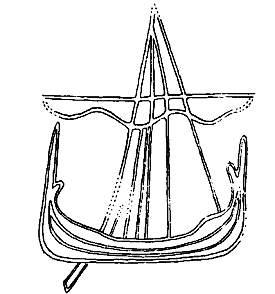
AT a meeting of the Natural History and Antiquarian Society, in October last, a description was gives of a newly discovered Cross-slab from Kirk Maughold, erected by Hedin to his daughter Lif, and dating probably from near the end of the twelfth century, which, for the first time in Mann, gives the figure of a ship.
The ancient Arms of the Kings of Man at a time when Heraldry had scarcely yet become a science, was a Ship which appears to have been adopted later by the Lords of the Isles when dropped by the Manx. Sovereigns In Camden’s time there was in the office of the Duchy, of Lancaster a perfect seal of Godred Crovan, which has now long disappeared ; this was described by him as bearing a "ship in ruff sables," the reverse showing the’ effigy of a man on horseback. A Seal of King Olaf to a charter in 1134 bore a ship with sails furled ; and, in the British Museum are two of King Harold, 1245 and 1246, showing the same design. These are figured in Oswald’s Vestigia, Manx Society, Vol. V. One shows neither sail nor yard, the other has the sail furled and remains of the Standard. But the form of the vessel is not in either case that of the Viking Ship which was high at the stem and stern and low amidships.
Of the Lords of the Isles, we find attached to a" Paisley Charter (circ. 1175) a seal of Reginald, second son of Somerled, which bears a ship filled with men-at-arms ; the reverse has a man on horseback like that of Godred Crovan, of whom his mother was a grand-daughter. Woodward’s "Heraldry" states that "in a’ seal of Angus of the Isles, of the year 1292, appended to a Homage Deed in the Chapter House at West minster. thw lymphad or gallery with furled sail, appears but not included in a shield." He gives as reference, Laing, Scottish Seals, i, No. 450.
Eventually the Ship passed to the descendants of Somerled, now become Lords of the Isles, and, possibly for that reason was dropped by our Manx Kings in the early days of Heraldry, giving place to the Three Legs, which design at an earlier date appears to have been in use along with it. We meet with the Ship on sepulchral monuments in Kintyre and the Western Isles, the series beginning about a century after that in the Isle of Mann had come to an end. These all show a vessel of the same form, single masted, with large square sail, and having high stem and stern ; the sail when shown is generally furled, but in Islay where there are eight examples, two have the sails spread ; sometimes stand-ards are shown and we know from the Sagas that these were set in the prow ; sometimes sailors are figured, in one case there is a man in the rigging; they all appear to have a fixed rudder at the stern.
In 1903, Mr. Collingwood made a most interesting discovery at Iona. In S. Oran’s Chapel he found on the back of a slab of which only the face had been previously figured "a large ship in which six little figures are apparently acting as crew, one seeming to manage the sail." This he takes to be work of the twelfth century and suggests it may have been erected to Godred, Olaf’s son, King of Man, who as we know from our Chronicle, died at S. Patrick’s Isle, in 1187, and was buried at Iona. Unlike the other examples referred to, this vessel shows no rudder.
Our Maughold Ship which is here figured half the actual size, may be of the same period as that from Iona, it shows the vessel cut in outline, high at stem and stern, slightly different in appearance from those in the Isles and showing distinctly the "lypting" or raised poop on which the commander stood and steered, with the bul
wark low amidships. The sail is furled and instead of the fixed rudder we find the steering oar near the stern on the right side, i.e., Stjornbordl—our ‘ Starboard." This alone serves to show its early date as compared with the examples mentioned, saving the exceptional one at Iona.

Is it to be regarded as a Heraldic bearing, and, if so, is the reference to the Lords of the Isles or to the Kings of Mann ? The inscription does not teach us, as unfortunately we have no contemporary records by which to discover who was Hedin that "set up" the Cross-slab, or Lif his daughter to whose memory it was erected. Though of early date however, it falls within the age when Heraldry was becoming established as a science, and, we may surmise that it is here to be regarded as a token of family and that the daughter’s descent, either on the father’s or the mother’s side could be traced up to Godren Crovan, from whom both the Kings of Mann and the Lords of the Isles derived the Ship as an Armorial Bearing.
P. M. C. KERMODE.
[for cross see no 7 p426]
|
|
||
|
Any comments, errors or omissions
gratefully received The Editor |
||